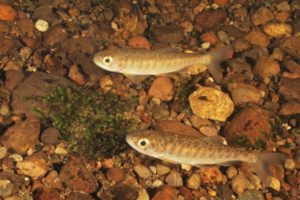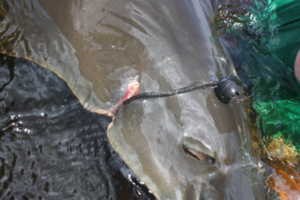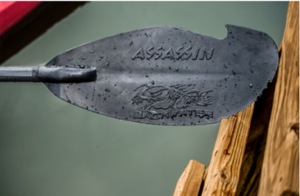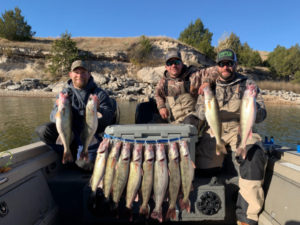Biologists Track Sauger on Arkansas River
Randy Zellers, Assistant Chief of Communications, Arkansas Game and Fish Commission
from the Fishing Wire
RUSSELLVILLE — Researchers at Arkansas Tech University are working with the Arkansas Game and Fish Commission to learn more about the habits of sauger swimming in the Arkansas River.
If you just had a curious look on your face after reading the word “sauger,” you’re probably not alone.
The sauger is a species of fish that is a cousin of the walleye, which is known for its fantastic flavor. While sauger and walleye have followings as large as crappie and bass angling up North and in the Midwest, they are pursued by a relatively small group of anglers in the southern states they inhabit. The Arkansas River holds the largest population of sauger in the state, but few anglers know much about the species.
“I occasionally get photos from anglers asking what the fish was that a person caught in the river while fishing for crappie and bass,” says Frank Leone, fisheries supervisor at the AGFC’s Russellville regional office. “Most of the time, people will ask if it’s a snakehead, and I have to explain to them that it’s not only a native fish, but a good one at that.”
The comparison may be a fair assessment to people who have seen neither but only heard descriptions of the invasive snakehead. Both have a mottled brown and bronze coloration and both have teeth, but that’s where the similarity stops. Sauger are much more streamlined than snakeheads, have peg-like teeth instead of the snakehead’s sharper triangular teeth.
Perhaps the reason for the lack of the species’ popularity comes from the relatively short window when anglers are truly able to pursue them. Each winter, sauger move upstream in the Arkansas River to find rocky, shallow areas to spawn. The many dams along the river that keep navigation open for commercial and recreational traffic hinder their progress, forcing most to congregate and spawn along the rocks just below each lock and dam. Grizzled old-school anglers have learned this pattern, and will walk to these riprap-covered areas to cast crappie jigs, minnows and other offerings when the current is right to collect some sauger for a midwinter fish fry. But outside of the spawning cycle, no one really knows what happens to these mysterious fish on the Arkansas River.
That’s where Arkansas Tech Graduate Student Peter Leonard comes in. He has been working under John Jackson, Ph.D, head of the Department of Biological Sciences and professor of Fisheries Science at Arkansas Tech University to track Arkansas River sauger throughout the seasons to learn more about the species. Leonard has worked with Leone on two studies concerning the species to help fill in the voids regarding the species’ use of habitat throughout the year and angling effort directed at sauger.
“The exploitation study was conducted using tags on fish collected during the spawning run of 2017,” Leonard said. “We caught sauger when they were concentrated, placed reward tags on the fish and released them. Anglers who caught the fish later could call the phone number on the tag and receive a cash prize for their catch.”
Leone says tag/recapture studies are used fairly often in fisheries work to determine how many fish anglers catch and keep from a population.
“If you have a certain amount of tags on fish, and anglers turn in a certain percentage, then you can use that to figure the rate of fish being caught,” Leone said. “While they are on the phone, we ask a few questions about where it was caught, if they kept the fish and if they were targeting that species, in particular, to give us a better picture of what’s going on out on the water.”
According to Leonard, 340 tagged fish were released below the dam that separates Lake Dardanelle and Pool 9 of the Arkansas River and below Ozark dam at the upper end of Lake Dardanelle early last spring.
“We have had very few tag returns so far, telling us that the exploitation rate for sauger last year was very low,” Leonard said.
Leone added that although the last two years saw high flows that could have disrupted angling effort, the results of the tag returns reinforce much of the anecdotal evidence he has had over the years that recreational fishing pressure has very little impact on sauger populations in the river.
“Flow rates are just something you have to deal with any time you study an aspect of a river fishery,” Leone said. “It’s part of the natural world, so you have to be prepared for events that are outside of your control.”
One interesting finding during the tag returns was the extreme distance from the release point in which some anglers found tagged fish.
“Most of our tag returns have come from below Barling dam above the next pool upstream from Dardanelle,” Leonard said. “In some cases the fish moved through two lock and dam systems to get to that destination.”
The second part of Leonard’s research reinforced some of those findings. In addition to fish with reward tags, researchers implanted special acoustic transmitters into sauger caught below Ozark dam and tracked the signals throughout the year to keep an eye on where the fish spent their time outside of the spawn.
“You rarely hear about people targeting sauger, but never hear about it any time other than winter,” Leone said. “So we wanted to learn where these fish went during the rest of the year to see if there were any habitats they relied on that we needed to keep in mind for conservation work.”
The telemetry equipment used in the research is very similar to sonar, but keys in on a specific frequency unique to each transmitter.
“We tracked individual fish as they moved around in the system,” Leonard said. “Most would stay within about 15 miles of where they were released, but a few travelled more than 100 miles upstream during the course of the year.”
Leone and Leonard agreed that, for the most part, sauger remained in the open river habitat, relying on current breaks in deeper, fast-moving sections when they are not concentrated for the spawn, which explains why few anglers find them outside of that window.
“Bass, crappie and other species most anglers are targeting will move to areas out of the current, so most of our anglers aren’t fishing where the sauger live long enough to have an appreciable catch rate.”
Leonard still has some data to compile for the study, and hopes to complete his thesis work on the project soon.
“We will go back and analyze the findings to determine fine-scale habitat types to recreate and protect once the study is complete and has been reviewed,” Leone said.



 Trolling walleye[/caption]
Trolling walleye[/caption]